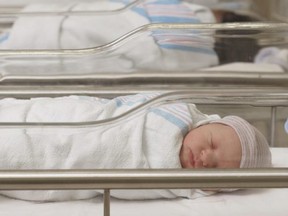London's birth rate among big-city Ontario's lowest (even before pandemic)

Article content
Forget baby boom. Think baby bust.
London is running a record-low birth rate, one of the lowest of major Ontario cities, latest figures show. And that was before the COVID-19 pandemic struck, which some experts predict will take birth rates even lower.
For a city that already counted heavily on newcomers to keep its growth going, it means London will need more outsiders – people moving in from elsewhere in Canada, and immigration from abroad, which has slowed during the pandemic – to keep its numbers up, one expert says.
“With this, it will be internal migration from other parts of Ontario and Canada that will be necessary in maintaining the city’s demographic growth, and to compensate for fewer births and fewer immigrants,” said Don Kerr, a demographer and professor at Western University’s King’s University College who has analyzed the latest figures.
Canada’s fertility rate, the number of children a woman will have over her reproductive life, has been declining for years and fell to an average 1.47 births in 2019, the lowest level ever. It’s well off the 2.1 rate needed to replace the population, a level not seen in Canada in decades.
A provincial breakdown of those 2019 numbers from Statistics Canada puts London near the bottom of the pile, at 1.37 births per woman compared to rates as high as 2.2 in Leamington and 1.76 in Chatham-Kent and Woodstock.
Other Southwestern Ontario centres – Brantford, Windsor, Waterloo Region, Guelph and Stratford – are running ahead of London in the latest numbers, and compared to major cities in the province, London is lagged only by Ottawa, Toronto and Kingston, with fertility rates as low as 1.23 births in Kingston.
Why London’s birth rate, lower than both the national and Ontario rates, has fallen so low isn’t clear, but it could reflect factors ranging from economics, to deciding to put off children until later in life, to an aging population and lifestyle choices.
Canada now relies mainly on immigration for its population growth.
“It is difficult to know, for sure, as there are a whole series of factors that might be responsible, and they play out differently in different areas,” Kerr said of London’s rate.
For example, he said, London hasn’t had the same kind of economic growth as some other major metropolitan areas over the last decade. And while that may be changing, younger people here have had a tougher time getting established than in some other major centres.
“This is likely relevant to fertility decisions, as young women often delay their child-bearing until their economic fortunes improve,” he said, while acknowledging that’s not a fool-proof explanation since fertility is higher in Windsor even though that city has, in recent years, struggled economically compared to London.
On the aging side, the London-area snapshot in the last census in 2016 mirrored both national and Ontario trends, with its percentage of seniors – 17.1 per cent of the population – slightly higher than the national average, while its ratio of children – 16.4 per cent – was slightly lower than Canada as a whole.
In the London area, the number of people living alone five years ago accounted for about 30 per cent of all households, with a slightly higher percentage made of up two people. The households with three or more occupants, those most likely to include children, accounted for about 35 per cent of the total.
Statistics aren’t yet available for 2020, but some observers including Kerr predict birth rates during the year of the pandemic will decline further.
“Market uncertainly does affect child-bearing plans and COVID is unprecedented,” Kerr said. “Most people end up having fewer kids than they plan to — life gets in the way.”
Women may decide not to have children for many reasons, said Brescia University College professor Helene Cummins, co-writer and lead editor on a new anthology called The Truth about M(O)therhood: Choosing to be Childfree.
Low income, fertility, mental health issues, responsibilities such as elder care, or simply not wanting children or to bring more people into an over-populated world can also be factors, she said.
“There are all kinds of different reasons for women to choose this lifestyle,” she said. “Perhaps it’s circumstantial: They didn’t find the love of their life early enough in their life to produce children.”
Other women may be so career-focused, they may not want to be hampered by a child, she said. “(They may have wanted) greater freedom in their life choices without the work of raising and socializing children.”
Michael Haan, a demographer at Western University, said he isn’t worried about the latest numbers for London, noting he would expect the fertility rate to rise with more millennials entering their 30s in the next few years. The latest census – the data was collected this month in Canada – should begin to tell the story, he said.
“We likely won’t know until the 2021 census results start flowing next year,” he said.
FERTILITY RATES: AVERAGE BIRTHS PER WOMAN 2019
Canada: 1.47
Ontario: 1.41
Woodstock: 1.76
Chatham-Kent: 1.76
Brantford: 1.67
Sarnia: 1.57
Windsor: 1.51
Hamilton: 1.49
Niagara Region: 1.44
Waterloo Region: 1.42
London: 1.37
Ottawa area: 1.33
Toronto: 1.31
Kingston: 1.23
Source: Statistics Canada






Postmedia is committed to maintaining a lively but civil forum for discussion. Please keep comments relevant and respectful. Comments may take up to an hour to appear on the site. You will receive an email if there is a reply to your comment, an update to a thread you follow or if a user you follow comments. Visit our Community Guidelines for more information.